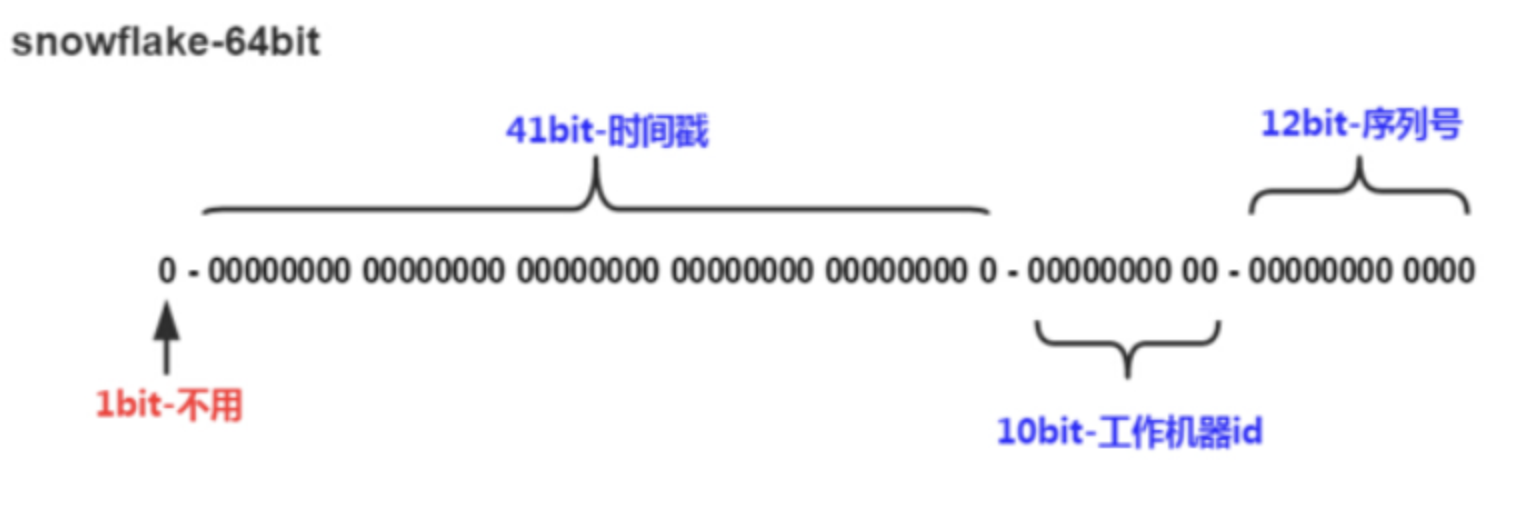简介
分布式id算法, 生成的id是一个long类型, java中long类型是8个字节, 64bit

- 第1位占用1bit,其值始终是0,可看做是符号位不使用。
- 第2位开始的41位是时间戳,41-bit位可表示2^41个数,每个数代表毫秒,那么雪花算法可用的时间年限是(1L<<41)/(1000L_3600_24*365)=69 年的时间。
- 中间的10-bit位可表示机器数,即2^10 = 1024台机器,但是一般情况下我们不会部署这么台机器。如果我们对IDC(互联网数据中心)有需求,还可以将 10-bit 分 5-bit 给 IDC,分5-bit给工作机器。这样就可以表示32个IDC,每个IDC下可以有32台机器,具体的划分可以根据自身需求定义。
- 最后12-bit位是自增序列,可表示2^12 = 4096个数。
另外,⼀切互联⽹公司也基于上述的⽅案封装了⼀些分布式ID⽣成器,⽐如滴滴的tinyid(基于数 据库实现)、百度的uidgenerator(基于SnowFlake)和美团的leaf(基于数据库和SnowFlake)
实现
public class IdWorker{//下面两个每个5位,加起来就是10位的工作机器idprivate long workerId; //工作idprivate long datacenterId; //数据id//12位的序列号private long sequence;public IdWorker(long workerId, long datacenterId, long sequence){// sanity check for workerIdif (workerId > maxWorkerId || workerId < 0) {throw new IllegalArgumentException(String.format("worker Id can't be greater than %d or less than 0",maxWorkerId));}if (datacenterId > maxDatacenterId || datacenterId < 0) {throw new IllegalArgumentException(String.format("datacenter Id can't be greater than %d or less than 0",maxDatacenterId));}System.out.printf("worker starting. timestamp left shift %d, datacenter id bits %d, worker id bits %d, sequence bits %d, workerid %d",timestampLeftShift, datacenterIdBits, workerIdBits, sequenceBits, workerId);this.workerId = workerId;this.datacenterId = datacenterId;this.sequence = sequence;}//初始时间戳private long twepoch = 1288834974657L;//长度为5位private long workerIdBits = 5L;private long datacenterIdBits = 5L;//最大值private long maxWorkerId = -1L ^ (-1L << workerIdBits);private long maxDatacenterId = -1L ^ (-1L << datacenterIdBits);//序列号id长度private long sequenceBits = 12L;//序列号最大值private long sequenceMask = -1L ^ (-1L << sequenceBits);//工作id需要左移的位数,12位private long workerIdShift = sequenceBits;//数据id需要左移位数 12+5=17位private long datacenterIdShift = sequenceBits + workerIdBits;//时间戳需要左移位数 12+5+5=22位private long timestampLeftShift = sequenceBits + workerIdBits + datacenterIdBits;//上次时间戳,初始值为负数private long lastTimestamp = -1L;public long getWorkerId(){return workerId;}public long getDatacenterId(){return datacenterId;}public long getTimestamp(){return System.currentTimeMillis();}//下一个ID生成算法public synchronized long nextId() {long timestamp = timeGen();//获取当前时间戳如果小于上次时间戳,则表示时间戳获取出现异常if (timestamp < lastTimestamp) {System.err.printf("clock is moving backwards. Rejecting requests until %d.", lastTimestamp);throw new RuntimeException(String.format("Clock moved backwards. Refusing to generate id for %d milliseconds",lastTimestamp - timestamp));}//获取当前时间戳如果等于上次时间戳//说明:还处在同一毫秒内,则在序列号加1;否则序列号赋值为0,从0开始。if (lastTimestamp == timestamp) { // 0 - 4095sequence = (sequence + 1) & sequenceMask;if (sequence == 0) {timestamp = tilNextMillis(lastTimestamp);}} else {sequence = 0;}//将上次时间戳值刷新lastTimestamp = timestamp;/*** 返回结果:* (timestamp - twepoch) << timestampLeftShift) 表示将时间戳减去初始时间戳,再左移相应位数* (datacenterId << datacenterIdShift) 表示将数据id左移相应位数* (workerId << workerIdShift) 表示将工作id左移相应位数* | 是按位或运算符,例如:x | y,只有当x,y都为0的时候结果才为0,其它情况结果都为1。* 因为个部分只有相应位上的值有意义,其它位上都是0,所以将各部分的值进行 | 运算就能得到最终拼接好的id*/return ((timestamp - twepoch) << timestampLeftShift) |(datacenterId << datacenterIdShift) |(workerId << workerIdShift) |sequence;}//获取时间戳,并与上次时间戳比较private long tilNextMillis(long lastTimestamp) {long timestamp = timeGen();while (timestamp <= lastTimestamp) {timestamp = timeGen();}return timestamp;}//获取系统时间戳private long timeGen(){return System.currentTimeMillis();}public static void main(String[] args) {IdWorker worker = new IdWorker(21,10,0);for (int i = 0; i < 100; i++) {System.out.println(worker.nextId());}}}

